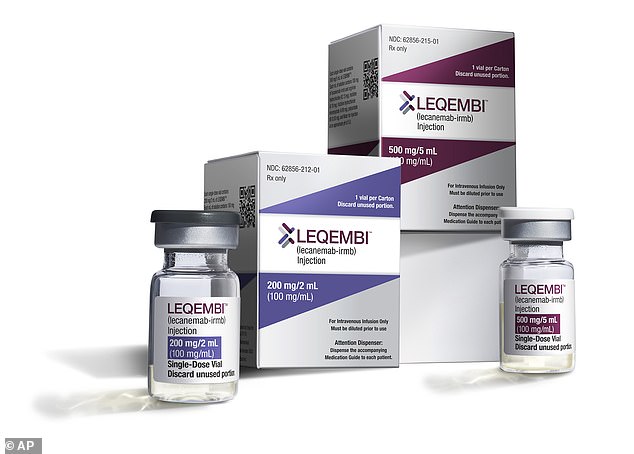NHS is still ‘a long way’ from routine Alzheimer’s testing to benefit from breakthrough drugs
Research shows the NHS is ‘a long way from being able to provide a new class of Alzheimer’s drugs to patients if they get approval.
Britain is about to decide whether the first treatments that slow the early signs of the disease are safe and effective.
Regulators are expected to rule on lecanemab in the coming weeks and on donanemab later this year, with both treatments now given the green light in the US.
Approval would mark a major change in treatment, as they target one of the known causes of Alzheimer’s disease, rather than just helping relieve symptoms.
But experts have warned that the lack of good testing means the NHS is being flooded with patients wrongly believed to have the disease.
Britain is about to decide whether the first treatments that slow the early signs of the disease are safe and effective

Regulators are expected to rule on the Alzheimer’s drug lecanemab (pictured) in the coming weeks and on another donanemab later this year
They said there is a ‘clear and urgent’ need to improve NHS screening to find out who could benefit from new Alzheimer’s drugs.
Researchers, including from University College London (UCL) and Queen Mary University, London, examined the clinical notes of 1,017 NHS patients in five areas of London, including 517 patients assessed in memory services and 500 in a specialist cognitive service.
Nearly a third (32 percent) of patients in memory services would likely be referred as potential candidates for the drugs.
Nearly all had brain scans, but only two patients received lumbar punctures, which confirm whether a patient had amyloid and tau proteins associated with Alzheimer’s disease.
This proportion increased in specialist clinics where more tests are available, with almost two-thirds (62 percent) receiving the necessary liquid biomarker tests.
When those who would not have been eligible for the treatments due to frailty and other issues, they found that four in 10 might be eligible for treatment with the new drugs.
In the Journal of Neurology, Neurosurgery and Psychiatry, researchers write that this corresponds to only 14 percent of all cases assessed in the specialized cognitive clinics.
Meanwhile, the lack of biomarker testing using lumbar punctures in patients seen in community memory clinics means that almost a third (30 percent) of suspected cases are not Alzheimer’s.
Researchers say NHS systems ‘must be set up to deal with this potential major discrepancy between referral and ultimate eligibility to avoid overwhelming services’.
Alzheimer’s disease is the most common cause of dementia and accounts for 80 percent of the 944,000 people with dementia in Britain.

Alzheimer’s disease is the most common cause of dementia and accounts for 80 percent of the 944,000 people with dementia in Britain
Currently, the only available medications for Alzheimer’s disease treat symptoms, but recent clinical trials show that new therapies – using monoclonal antibodies to clear amyloid plaques that form on the brain – can slow disease progression.
Two ‘disease-modifying therapies’ (DMTs) have been given ‘breakthrough therapy’ status in Britain and could become available to patients by the end of the year, pending approval by the MHRA and then NICE.
David Thomas, head of policy and public affairs at Alzheimer’s Research UK, said cheaper, more scalable diagnostics, such as blood tests, were urgently needed.
He said: ‘New drugs for Alzheimer’s disease are finally on the horizon, but to realize their full potential, healthcare systems must be able to offer people with symptoms of dementia accurate and early diagnosis to find out whether these treatments can benefit them come.
‘As this research shows, the NHS is still a long way from being able to carry out these tests routinely.
‘Whoever forms the next government must urgently invest in the NHS to ensure we have the right diagnostics and workforce to help identify people who could benefit from new treatments if these are deemed safe and effective by regulators are considered.’
A report published by NHS England earlier this year said that ‘timely diagnosis of dementia is vital’, with the addition of new blood tests could soon replace lumbar punctures in diagnosing the disease.
It predicts that the number of patients potentially eligible for the drugs will range from 50,000 to 280,000, with an estimated cost of £500 million to £1 billion per year.
However, actual costs will depend on the drug prices agreed for England.
The document states: ‘To be eligible for treatment, patients must first undergo an MRI scan and then a PET-CT scan or a lumbar puncture which confirms the presence of beta-amyloid proteins in the brain, which are linked to Alzheimer’s disease. disease process.’
Dr. Alex Osborne, policy manager at the Alzheimer’s Society, said: ‘These drugs are only available to people in the early stages of Alzheimer’s disease – and more than a third of the 982,000 people with dementia in Britain have no diagnosis at all.
‘That’s why the Alzheimer’s Society is calling on the NHS to publish plans on how it will deliver groundbreaking new treatments to the people who need them, with a specific focus on diagnosis and investment in the tools and staff needed to help eligible identify patients.’
